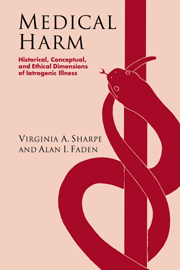Book contents
- Frontmatter
- Contents
- Acknowledgments
- Introduction
- Part I
- Part II
- Part III
- 7 From hospitalism to nosocomial infection control
- 8 Adverse effects of drug treatment
- 9 Unnecessary surgery
- 10 The concept of appropriateness in patient care
- 11 Recommendations for limiting iatrogenic harm
- Appendix
- Bibliography
- Index
11 - Recommendations for limiting iatrogenic harm
Published online by Cambridge University Press: 22 September 2009
- Frontmatter
- Contents
- Acknowledgments
- Introduction
- Part I
- Part II
- Part III
- 7 From hospitalism to nosocomial infection control
- 8 Adverse effects of drug treatment
- 9 Unnecessary surgery
- 10 The concept of appropriateness in patient care
- 11 Recommendations for limiting iatrogenic harm
- Appendix
- Bibliography
- Index
Summary
As we have noted, studies relating to the incidence of iatrogenic or comiogenic illness have suggested that perhaps one-quarter to one-half of such events are potentially preventable. The most convincing documentation for preventable or potentially preventable adverse drug events comes from the work of Leape and colleagues, initially in the large retrospective medical practice study of New York hospitals, and more recently, in prospective studies of adverse drug events in Boston teaching hospitals. These studies, together with others from the field of nosocomial infection control, suggest that prevention strategies should involve attention to five broad but highly interrelated areas. These include the development of active surveillance methods, improvement in information technology, incorporation of systems analysis techniques, education, outcomes research, and implementation of continuous quality improvement. Of these, quality improvement has been discussed in previous chapters and will be addressed only in relation to the other strategies.
Surveillance strategies
Active surveillance methods have been used with considerable success to gather reliable information regarding incidence and causes of several major classes of iatrogenic illness, as well as to document the effectiveness of preventive strategies. In numerous studies, the use of active surveillance has identified a dramatically higher incidence of adverse drug reactions (ADRs) as compared to more traditional passive reporting approaches or retrospective chart reviews. Active surveillance, particularly when combined with computerization of medical records/ordering and continuous quality improvement techniques, have led to a reduction in the incidence of specifically identified types of drug-drug interactions.
- Type
- Chapter
- Information
- Medical HarmHistorical, Conceptual and Ethical Dimensions of Iatrogenic Illness, pp. 230 - 240Publisher: Cambridge University PressPrint publication year: 1998



